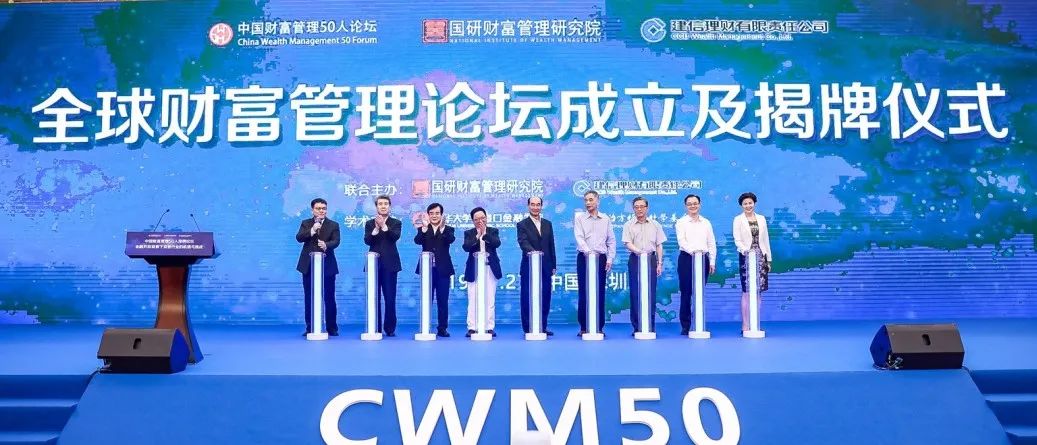信安金融集团董事长:多支柱保障的全球经验与中国实践

信安金融集团董事长、总裁兼首席执行官侯智彤先生(Daniel J. Houston)近日出席全球财富管理论坛上海苏河湾峰会时,就养老金体系在金融支持国家发展方面的重要作用发表演讲。
作为成立近一个半世纪、在华展业二十多年的全球养老金管理机构负责人,侯智彤先生通过陈述社会日益老龄化背景下多支柱养老保障体系的积极作用,高度评价了中国正在进行的多支柱养老金体系建设,表达了信安希望深度参与到中国养老金市场建设的意愿。侯智彤先生借墨西哥和智利两国的养老保障体系为例,辅以大量翔实的数据支撑,分析梳理了建立一个完善的养老保障制度所必要的基本逻辑,并以信安经验总结出一些值得后发市场借鉴的建议。最后,侯智彤先生特别提到,相比以往,中国目前的养老保障体系建设有一大优势,那就是可以运用数字化工具,将金融科技与制度建设相结合,促进养老金管理的创新,同时还可以迅速推动资本市场深化,为公共产品的关键领域打通资金渠道。
以下为演讲全文。

今天,我和大家探讨一下养老金体系在金融支持国家发展方面的重要作用。信安提供财务和退休保障服务的历史已逾140年。在这140年间,我们从一家美国本土的保险及退休金服务供应商发展成今天的全球资产管理机构。目前,我们的服务覆盖了包括中国市场在内全球八十多个市场的4,900余万消费者,其中有近2,500万消费者来自中国。一路走来,信安构筑起了针对新兴市场养老金管理的专业能力。
如今,信安是美国前三大退休金服务商之一,是拉丁美洲最大的养老金管理公司之一,在亚洲也有规模庞大的养老金和长期储蓄业务。我们与合资伙伴中国建设银行密切合作,在华资产管理业务已开展了二十多年,为中国客户提供安全的长期储蓄选择。
低准入门槛且安全可靠的长期储蓄工具构成了有效的养老金体系。反过来,有效的养老金体系能够为百姓及其家人们提供终身财务保障,宏观上也促进了资本市场对公共产品的补充,减轻了政府财政支出压力,为重大的公共支出事务提供了新的选项。
中国已启动旨在大幅加强多支柱养老金体系的建设进程,统筹所有省份第一支柱,即基本养老金,并且致力扩大第二和第三支柱养老金储蓄。这些变革不仅务实,而且能以前所未有的力度调动国内资本,未来这些资本将被用来负担老龄化社会带来的成本,为无数国民提供终身财务保障,并且创造在未来能够为实体经济提供资金的资本市场。
我在这里分享几个数据。全球养老金资产在过去十多年加速增长。2010年,全球养老金管理资产规模为30万亿美元。而到了2020年,该数字几乎翻倍,达到56万亿美元。其中,美国养老金资产占到35万亿美元。我们认为,这充分说明通过公共政策发展完全积累制的多支柱养老金体系颇有裨益,为个人退休保障带来了巨大价值。
随着社会日益老龄化、人口寿命不断延长,经济学家们警告说,政府在提供长期退休保障方面的行动速度还不够快。如果像中国政府这样建设积累制养老金体系,社会效益将随储蓄的积累而得到快速发展。
在此,我分享两个典型案例。
首先说墨西哥。墨西哥在1997年建立了强制性的个人积累养老金制度,简称AFORE。尽管这一强制性制度仅将墨西哥民众工资的6.5%纳入养老金储蓄,但经过一代人的积累,AFORE管理的资产规模已经增加到2,460亿美元,相当于墨西哥GDP的21%。
AFORE的养老金管理人包括墨西哥本土和全球性的养老金公司,其资产年均收益率为5.38%,相当于墨西哥GDP的1.12%。每年的收益和新增缴费一起被投资于墨西哥的公共和私营部门,还有一小部分投资于外国资产。AFORE的资金中,约有750亿美元投向墨西哥股票、公司债券、墨西哥本土REITs,以及促进经济增长的其它标的,由养老金储蓄投资支撑的资本市场已经成为墨西哥工商业最重要的融资渠道之一。AFORE的另外1,710亿美元资金被多元化地配置于墨西哥公共部门、本土私募资产及海外资产。
2020年,墨西哥国会通过了对AFORE制度具有里程碑意义的改革措施,将极大增强墨西哥民众的财务保障,同时扩大对于墨西哥具有重要意义的资本市场。AFORE制度自设立以来完全依赖个人储蓄,但自2023年起,墨西哥将强制要求雇主参与缴费。雇主缴费率将用八年时间逐步从工资的6.5%提高到工资的15%,到2030年,雇主缴费率将是雇员缴费率的两倍多。这一改革意味着到2030年雇主缴费率稳定后,墨西哥民众的平均退休后收入替代率将从目前的28%提高到53%。也就是说,与当前相比,今后墨西哥工薪阶层和中产阶级的退休生活将更有保障。
值得强调的是,墨西哥养老金体系的这一改革获得了包括工会、最大的行业协会、经济学家以及国会等国内各利益相关方的政治支持。这些不同的群体,尤其是墨西哥最大的企业主们,认识到这一改革不仅增加了养老储蓄以应对社会的快速老龄化,也有助于整个国家实现共同富裕。
第二个例子是智利的AFP养老金制度,相信业界的养老金专家们已非常熟悉。智利是推动直接积累制养老金的先行者,在上世纪八十年代初用AFP养老金制度替代了难以为继的现收现付养老金制度。由智利民众养老金资产支持的资本市场已经成为全拉丁美洲为国家发展提供融资渠道的典范。截至2021年12月,AFP管理的资产规模为1,920亿美元,相当于智利GDP的76%。从1981年6月到2020年12月期间,AFP的私营管理公司的年均实际收益率为8%。
AFP的资金中,约有630亿美元投向智利股票、公司债券、本土REITs,以及其它标的,由此支持的资本市场已经成为智利工商业最重要的融资渠道之一。AFP的另外1,290亿美元资金被多元化地投资于公共部门、本土私募资产及海外资产。包括政府债券在内的国内投资占总投资的54%,而国际资产配置占46%。对智利消费者来说很重要的一点是,由养老金支持的资本市场有效支撑了长期抵押贷款融资,帮助智利构建起拉丁美洲负担最低的住房市场。
自1981年建立以来,智利的强制性养老金制度也对私人储蓄总额产生了积极影响。据估计,AFP制度在建立后的前三十年里,对储蓄总额的影响相当于GDP的2.7%,对投资的影响相当于GDP的1.2%,对GDP水平的影响在8.6%到14.4%之间。对智利国民储蓄的这一积极影响也增加并稳定了智利资本市场中可用资金的供应,为金融机构和企业提供了长期投资的资金来源。
智利模式仍是迄今全球养老金行业的标杆。但也必须承认,尽管AFP取得了令人惊叹的成果,这个制度自上世纪八十年代初建立伊始就存在着重大设计缺陷,且一直带病运行。AFP的人均储蓄率保持在10%,远低于OECD经济体19%的平均水平。
养老金行业一直鼓励智利政府推行关键改革,以提升智利民众的退休保障程度。为完善养老金制度,智利迫切需要实施三项改革。一是按照智利众多专家和养老金倡导者的建议,实行6%的雇主缴费率。二是大幅提高当前只能缴纳个人工资10%的缴费上限,以及放开对个人总收入超出38,000美元部分的计缴限制。三是扩大正式员工与临时工的自愿储蓄计划,并为雇主和雇员提供适当的税收激励。信安已经与同行一起,联合OECD等组织,鼓励智利政府开展上述改革,以确保智利能够维持已经惠及两代人的优异公共福利。
尽管养老金改革仍是一个动态目标,但是我们从墨西哥和智利的案例中可以看出,动员国民在积累制的多支柱养老金体系中增加储蓄,将具有显著的社会效益。值得重申的是,积累制的多支柱养老金体系将在至少三个方面对国民有所帮助。一是增强国民的终身财务保障;二是深化资本市场,为私营部门的经济活动和公共产品提供融资;三是减轻政府的财政负担,应对随社会老龄化及人口不断长寿而来的挑战。
对于中国建设完善养老金制度的举措,我们深受鼓舞。中国的政策制定者们已经认识到开展养老金改革、应对快速老龄化挑战的紧迫性,这一点值得称赞。在接下来的三十年里,中国将有三分之一的人口达到退休年龄。好在中国已开始逐步提高人均养老金储蓄率,以应对这一挑战。目前,中国企业年金和职业年金的资产规模已达5,500亿美元。
中国的政策制定者正努力缩小社会群体间的收入差距,以鼓励广泛的财富创造。这是多数国家都会遇到的政策挑战,包括我刚才提到的那些国家。但是,中国有一大优势,那就是可以运用数字化工具,将金融科技与制度建设相结合,促进养老金管理的创新,同时还可以迅速推动资本市场深化,为公共产品的关键领域打通资金渠道。
我赞同中国银保监会主席郭树清最近发表的观点,中国要“加快养老保险第二和第三支柱建设,推动养老基金在资本市场上的占比达到世界平均水平。”我们十分赞同中国将长期退休财富积累纳入中国应对老龄化社会挑战的国家战略。备受期待的第三支柱政策将让中国人民有机会拥有自己的个人退休账户,藉此引导万亿级银行储蓄的一部分投资于各种稳健的合格养老金产品,从而转化为长期资产。
随着中国继续完善其退休政策框架,我们期待在相关讨论中纳入适当的税收激励政策、打造就业驱动的养老新支柱,以及为上亿中国民众提供养老储蓄方面的教育、引导及咨询。信安一个半世纪以来都在为客户的长期财务安全保驾护航。我们认为,这种稳健的投资态度是本行业对资本管理最重要的贡献之一,首先是客户至上,进而惠及天下苍生。
中国养老金体系第二和第三自愿性支柱的发展,能为广大中国人民的财务安全提供保障,同时推动资本市场成为新的经济增长引擎。我们已在中国经营了近二十年,我们期待在未来更长的时间里继续合作,支持中国建立稳健而持久的养老金体系,进而有效地服务于中国客户的未来。

Speech at GAMF 2022
Shanghai Summit
Daniel J. Houston
Today, I want to discuss the role of pension systems in financing national development. At Principal, we've provided financial and retirement security for over 140 years. Over the course of our history, we've grown our business from insurance and retirement in the United States, to global asset management, serving more than 49 million customers in 80 plus markets around the world, including China where we serve nearly 25 million customers. During this time, we've developed a specialized expertise and knowledge in managing pension funds in emerging markets.
Today, Principal is one of the Top 3 retirement providers in the U.S., one of the largest pension fund managers in Latin America, and we have substantial pension and long term savings operations across Asia. In China, we've operated an asset management business for nearly two decades, working closely with our joint venture partner, China Construction Bank, to provide secure long term savings options for customers across China.
Accessible, secure, and dependable long term savings vehicles are what form effective pension systems. In turn, effective pension systems can provide people and their families with lifetime financial security; it can build capital markets that invest in public goods for the benefit of society; and it can provide governments with additional fiscal space to make choices about public spending.
China has embarked on a course to significantly improve the country's multi-pillar pension system, strengthening the first pillar social pension scheme across all provinces and working to expand second and third pillar savings. These changes are not only pragmatic, they are also poised to mobilize unprecedented amounts of domestic capital that will offer protection against the costs of an aging society, generate lifelong financial security for millions of citizens, and create capital markets capable of financing the real economy for generations to come.
A couple of proof points. First, global pension assets have grown at an accelerated rate over the past 10 plus years. In 2010, global pension assets under management were valued at $30 trillion. And by 2020, that figure nearly doubled, to $56 trillion USD. Second, the U.S. pension market itself accounts for $35 trillion of the global total. At Principal, we view this as evidence that public policies that support the development of fully funded, multi-pillar retirement systems are worth the investment and create great value for individuals' retirement security.
As economists have turned their attention to the challenges of aging and increasing longevity, they have warned that governments are not acting quickly enough to secure retirement finance for the long term. However, the good news is that where governments, like China, have deployed funded systems, societal benefits have developed as quickly as savings have accumulated. This is the path that China is pursuing, and if history is the guide, the changes sought by Chinese policymakers are exceptionally promising.
I'll share with you a couple examples from two other economies that began this journey earlier.
Starting with Mexico. Mexico created its individual, mandatory, funded pension system, the AFORE system, in 1997. In about a generation's time, with Mexican workers saving only 6.5% of their wages in the mandatory scheme, the total assets under management (AUM) in the AFORE system have grown to $246 billion, which is roughly 21% of Mexico's gross domestic product.
The AFORE pension fund managers, constituted by a group of Mexican and global pension fund firms, have averaged annual returns of 5.38%, or 1.12% of GDP. These returns plus the contributions are annually invested in both the Mexican public and private sectors. A smaller portion is also invested in foreign assets. The capital market backed by AFORE assets is one of the most significant sources for business and industrial finance in Mexico, investing some $75 billion in Mexican equities, corporate bonds, local Mexican REITS and other instruments critical to growth. The remaining $171 billion assets in the system are diversified among Mexican public sector instruments, local private assets, and foreign assets.
In 2020, the Mexican Congress passed landmark reforms of the AFORE system that will substantially increase financial security for Mexican workers while expanding this vital capital market. Beginning in 2023, Mexico will add a mandatory employer contribution to a system that has relied solely on individual worker savings since its inception. By 2030, the new employer contribution will more than double the savings rate for workers, rising gradually from 6.5% of wages to 15% of wages over 8 years. These reforms will mean an increase in retirement income replacement rates on average from 28% today, to 53% for Mexican workers, after the employer contribution stream is fully phased in 2030. Meaning that Mexico's working and middle classes will be much more prepared for retirement in the future than they are today.
It's important to note that these reforms to the pension system received political support across a spectrum of stakeholders in Mexico, including labor unions, the country's largest industry associations, as well as economists and the Mexican Congress. These constituencies, including most importantly Mexico's largest employers, recognized the value not only of increased pension savings as a hedge against rapid aging, but the shared prosperity provided to the country as a whole.
The other example I'll share with you is one that any pension expert in the audience will know well. Chile was a pioneer in the promotion of directly funded pension systems, in the early 1980's replacing an unsustainable pay-as-you-go system with the AFP pension system. The capital market backed by the pension assets of Chilean workers has become Latin America's deepest reservoir of national finance. As of December 2021, total assets under management in the AFP system were $192 billion, roughly 76% of Chile's GDP. Average annual real returns on assets managed by the private companies that administer the AFP system, between June 1981 and December 2020 were 8%.
The capital market backed by AFP assets is one of the most significant sources for business and industrial finance in Chile, investing some $63 billion in Chilean equities, corporate bonds, local REITS, and other instruments. The remaining $129 billion are diversified among public sector instruments, local private assets, and foreign assets. Domestic investments, including government bonds, represent 54% of total investments, while international allocation is 46%. Importantly for Chilean consumers, the pension backed capital market has effectively underwritten long term mortgage finance, helping to create one of the most affordable housing markets in Latin America.
Since its creation in 1981, Chile's mandatory pension system has also generated a positive effect on total private savings. It's estimated that during the first 30 years of the AFP system the impact on total savings was 2.7% of GDP. The effect on investment was 1.2% of GDP. And the effect on the level of GDP was between 8.6% and 14.4%. This positive influence on national savings in Chile both increased and stabilized the supply of funds available in the national capital market, which provided financial institutions and companies access to financial resources for long term investments.
The Chilean model remains a benchmark for the global pension industry. But, it's important to acknowledge that Chile's AFP system has delivered these impressive results despite working within significant design flaws that have existed since the system's inception in the early 1980's. Per capita, savings in the mandatory AFP system remain at 10%, which is much lower than the average across OECD economies of 19%. The pension industry has consistently encouraged Chilean governments to take up key reforms to improve retirement preparedness for Chileans.
To improve the Pension system, three reforms are critically needed. First is initiating an employer contribution of 6%, as proposed by a number of experts and pension advocates in Chile. Second is raising the salary cap on the 10% personal contribution significantly, to allow savings above the artificially low $38,000 limit that was put in place in the 1980's. Third is expanding voluntary savings programs for both formal and informal (gig) workers, with appropriate tax incentives for employers and employees. We have joined our industry as well as organizations such as the OECD in encouraging these kinds of reforms in Chile, to ensure the country maintains the extraordinary public benefits that have accrued from two generations of savings.
Although pension reform remains a moving target, we can see from Mexico and Chile that there are clear societal benefits to mobilizing national savings in a funded, multi-pillar system. It's also worth repeating that funded, multi-pillar systems help nations in three ways. First, by providing improvements to lifelong financial security for people. Second, by building deep capital markets that finance private economic activity as well as public goods. And third, by relieving governments of a portion of the costs of aging societies and longevity risk.
These benefits are among the many reasons we're encouraged by the pension policy developments happening in China. Chinese policymakers are to be commended for recognizing the urgency given to pension reform due to rapid aging. Within the next 30 years, one in three Chinese citizens will reach retirement age. China, however, has already started building up per capita private pension savings to meet this challenge, with $550 billion in assets under management in the country's Enterprise Annuity and Occupational Annuity retirement savings programs.
China's policymakers are encouraging broad wealth creation in a way that reduces income gaps across various social demographics. This is a policy challenge encountered by most countries, including the ones I mentioned earlier. However, China is in a favorable position to leverage innovations in both pension system design and fin-tech digital tools to mobilize pension savings in a way that rapidly builds a deep capital market, the kind that can provide critical finance to important areas of public development.
I appreciate recent comments by CBIRC Chairman Guo Shuqing that China should "accelerate the growth of pillar two and pillar three pension so that pension funds become a major force in China's capital market to a level as high as those in other developed countries." We could not agree more that long term wealth accumulation for retirement should be part of China's national approach to offset the challenges of an aging society. The much anticipated pillar three policy will offer the chance for Chinese citizens to have their own Individual Retirement Accounts, where part of the trillions of yuan in bank savings can be channeled into long term assets investing in a variety of stable, qualified pension products.
As China continues to develop its retirement policy framework, we look forward to discussions that include the appropriate role of tax incentives, the merits of an employment based pillar or option, and how the pension industry can help provide financial education, guidance, and advice to millions of Chinese workers. At Principal, we've spent almost a century and a half helping our customers safeguard their long term financial security. We believe this type of stable investment approach is one of our industry's most important contributions to capital management, not only for our customers, but also in the societies, in which we operate.
The evolution of the second and third, voluntary pillar of China's pension system will allow millions of more Chinese people to protect their financial futures, while also building a capital market that can serve as an engine of economic growth and development. We've partnered with China over the last 20 years, and we look forward to many more decades of continued collaboration to build a stable and durable pension system positioned to effectively help our Chinese customers for generations to come.
全球财富管理论坛

全球财富管理论坛是在金融开放背景下,为顺应全球资产管理行业发展与中国资产管理行业转型需求,由清华大学经济管理学院、孙冶方经济科学基金会、中国财富管理50人论坛联合发起成立的一个国际性交流平台组织,论坛旨在构建一个汇聚全球资产拥有者和管理者、监管部门和市场代表的长期对话沟通平台,为国内外资产管理机构搭建交流与合作的桥梁。

